
Saint George and the Princess is a fresco by the Italian master Pisanello, located in the Pellegrini Chapel of the Church of Sant'Anastasia, Verona, northern Italy. It is one of the most notable works of International Gothic painting.

Saint George and the Princess is a fresco by the Italian master Pisanello, located in the Pellegrini Chapel of the Church of Sant'Anastasia, Verona, northern Italy. It is one of the most notable works of International Gothic painting.
The work was commissioned by the Pellegrini family, as testified by Andrea Pellegrini's testament of 1429. The external fresco, only partially preserved, was part of a cycle decorating the whole chapel.
The date of the work is uncertain. It is generally assigned to the period between the painter's return from Rome in 1433 and his departure to Ferrara in 1438. The terracotta decoration of the chapel is documented as existing in 1436 and the frescoes are perhaps from the same period, although the two works would hardly coexist. Some scholars date it to 1444-1446, after the Council of Ferrara, due to details connected to the Byzantine diplomats who took part in the latter (such as the horse with broken nostrils used by the Byzantine Emperor John VIII Palaiologos, or the style of some figures' hats). Such details could however come from Manuel II Palaiologos' procession at the Council of Constance (1414–1418): similar elements existed in the lost frescoes by Pisanello in St. John Lateran, documented by some surviving drawings based on those frescoes.
The fresco was long exposed to water seepage from the ceiling of the church and was severely damaged, especially in the left part which contains the dragon. The surviving part was detached from the wall in the 19th century, but this caused the loss of the metallic and gilt decorations.
The fresco was formed by two parts: the right one, with St. George leaving the Princess of Trebizond (Trabzon), which is in good condition; and the left one, with the dragon in the sea, which is nearly lost.
The surviving section shows the moment of St. George's legend in which he is mounting his horse (shown from the rear) before sailing to kill the dragon which was to devour the daughter of the city's king. Behind the princess, on the right, are three horses with knights, and a crouched ram. On the left are a hound and a companion dog.

The painting is highly detailed in the armor, the harnesses, and the garments of the princess and her following. The princess has an elaborate hairdo, with bends holding a large mass of hair; the latter begins very high on the brow, according to a style which was popular in the early 15th century, obtained by cutting the hair on the brow and the temples with a lit candle. [1] The princess' dress is a sumptuous one in cloth and fur. The animals show Pisanello's passion for the portrayal of natural elements.
The left part is occupied by a procession of curious people, depicted in smaller proportions, who have gathered near the place where George's boat is ready to sail off. Their faces show a variety of portraits, which were accurately studied as testified by the numerous drawings executed by Pisanello and his workshop (now mostly housed in the Vallardi Codex, at the Cabinet des Dessins of the Louvre Museum in Paris). Among them are two grotesque faces, perhaps inspired by the descriptions of Ottoman Turks who were besieging Constantinople, or perhaps by the older accounts of the Golden Horde.

The upper part features a high cliff with an idealized depiction of Trabzon with rich architecture of towers, spires of religious buildings and, on the far right, a castle. Typical of International Gothic, there are some macabre and grotesque elements: outside the city walls are two hanged men, one with his hose fallen. The latter were perhaps inspired by the daily experience of the author at the Piazza delle Forche in Florence ("Gallows Square"). [2]
Some original color details are lost, including the tempera layer above the face, which now has become pale white; the sky, now heavily darkened; the silver of the armor, obtained by metal insertions, has now disappeared leaving a nearly black surface.
In the damaged section of the fresco, only a few details have survived. The most significant of these is a salamander walking among the bones and other remains of the dragon's victims.
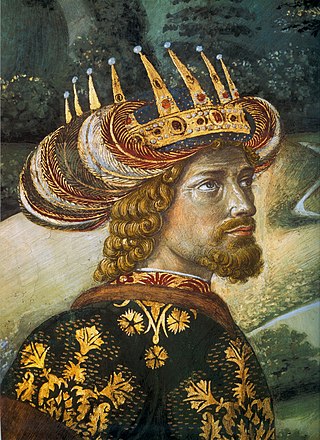
John VIII Palaiologos or Palaeologus was the penultimate Byzantine emperor. Ruling from 1425 to 1448, he attempted, and failed, the reunification of the Orthodox and Catholic churches and prioritized the protection of Constantinople against the Ottoman Empire. He was succeeded by his brother, Constantine XI.

Pisanello, born Antonio di Puccio Pisano or Antonio di Puccio da Cereto, also erroneously called Vittore Pisano by Giorgio Vasari, was one of the most distinguished painters of the early Italian Renaissance and Quattrocento. He was acclaimed by poets such as Guarino da Verona and praised by humanists of his time, who compared him to such illustrious names as Cimabue, Phidias and Praxiteles.

Vincenzo Foppa was an Italian painter from the Renaissance period. While few of his works survive, he was an esteemed and influential painter during his time and is considered the preeminent leader of the Early Lombard School. He spent his career working for the Sforza family, Dukes of Milan, in Pavia, as well as various other patrons throughout Lombardy and Liguria. He lived and worked in his native Brescia during his later years.
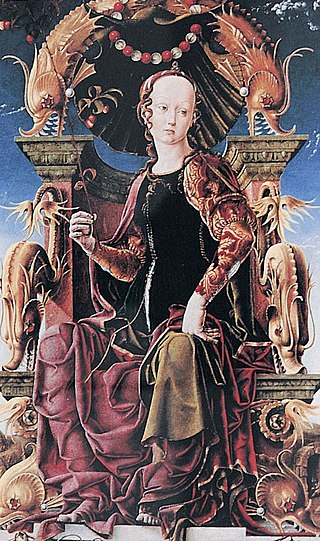
Cosmê Tura, also known as Il Cosmè or Cosimo Tura, was an Italian early-Renaissance painter and considered one of the founders of the School of Ferrara.

Palazzo Schifanoia is a Renaissance palace in Ferrara, Emilia-Romagna (Italy) built for the Este family. The name "Schifanoia" is thought to originate from "schifare la noia" meaning literally to "escape from boredom" which describes accurately the original intention of the palazzo and the other villas in close proximity where the Este court relaxed. The highlights of its decorations are the allegorical frescoes with details in tempera by or after Francesco del Cossa and Cosmè Tura, executed ca 1469–70, a unique survival of their time.

The Brancacci Chapel is a chapel in the Church of Santa Maria del Carmine in Florence, central Italy. It is sometimes called the "Sistine Chapel of the early Renaissance" for its painting cycle, among the most famous and influential of the period. Construction of the chapel was commissioned by Felice Brancacci and begun in 1422. The paintings were executed over the years 1425 to 1427. Public access is currently gained via the neighbouring convent, designed by Brunelleschi. The church and the chapel are treated as separate places to visit and as such have different opening times and it is quite difficult to see the rest of the church from the chapel.
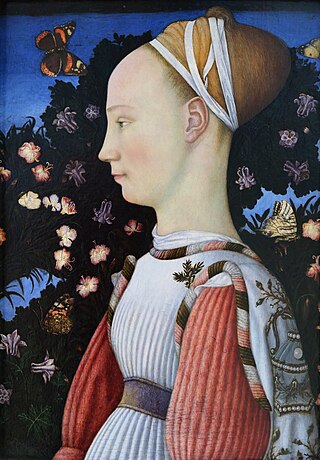
Portrait of Princess is a tempera painting on panel attributed to the Italian Late-Gothic master Pisanello. It was probably executed between 1435 and 1445 and is also known as Portrait of a Princess of the House of Este. It is firmly attributed to Pisanello on stylistic grounds and because he stayed in Ferrara in the period, where he also finished a portrait and a celebrative medal of Marquis Leonello d'Este.

The chiesa di Sant'Anastasia, or the Basilica of Saint Anastasia is a church built by the Dominican Order in Verona, northern Italy. In Gothic style, it is the largest church in the city, located in its most ancient district, near the Ponte Pietra.

Saint Francis Receiving the Stigmata is a panel painting in tempera by the Italian artist Giotto, painted around 1295–1300 for the Church of Saint Francis in Pisa and it is now in the Musée du Louvre in Paris. It shows an episode from the life of Saint Francis of Assisi, and is 314 cm high by 162 cm wide. It is signed OPUS IOCTI FLORENTINI.
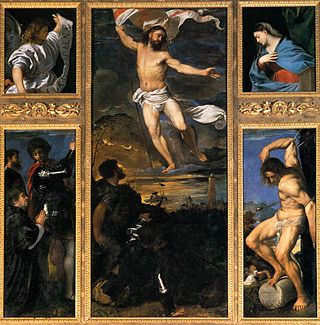
The Averoldi Polyptych, also known as the Averoldi Altarpiece, is a painting by the Italian Renaissance painter Titian, dating to 1520–1522, in the basilica church of Santi Nazaro e Celso in Brescia, northern Italy.

The Entombment of Christ is a c. 1520 painting by Titian, now in the Musée du Louvre, in Paris.

Vanity is an oil painting by the Italian late Renaissance painter Titian, dated to around 1515 and now held at the Alte Pinakothek in Munich, Germany.
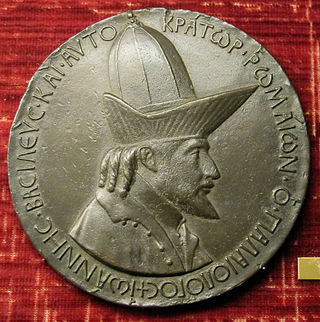
The medal of John VIII Palaeologus is a portrait medal by the Italian Renaissance artist Pisanello. It is generally considered to be the first portrait medal of the Renaissance. On the obverse of the medal is a profile portrait of the penultimate Byzantine emperor, John VIII Palaeologus; the reverse contains an image of the emperor on horseback before a wayside cross. Although the date of the work is not clear it was likely to have been some time during 1438 and 1439, the years John was in Italy attending the Council of Ferrara. It is not known whether the emperor himself or his Italian hosts commissioned Pisanello to make the medal, but Leonello d’Este, the heir apparent to the marquisate of Ferrara, has been suggested as the most likely candidate. Several drawings by Pisanello are closely associated with the medal and these include sketches now held in Paris and Chicago.

The Northern Master was an anonymous artist in the late 13th century who worked in the Upper Church of the Basilica of Saint Francis of Assisi. Although his precise origin is unknown, he is thought to be of French, German, or English origin. He and his assistants played a critical role in painting by merging northern Gothic and Italian influences in the frescoes. Also attributed to him are the designs for some of the stained glass windows.

The Campori Madonna is an oil-on-panel painting executed ca. 1517–18 by the Italian Renaissance painter Antonio da Correggio.

Madonna and Child with Two Saints or Madonna and Child with Saint Anthony Abbot and Saint George is a panel painting by Pisanello, executed c. 1445, now in the National Gallery, London. It is his only signed panel work ("Pisanus").
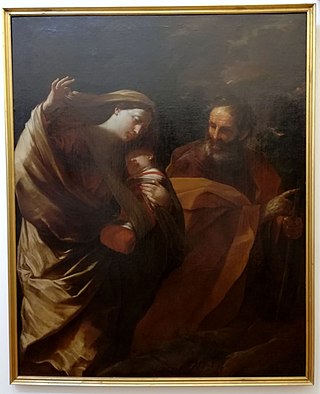
The Flight into Egypt is a c. 1622 oil on canvas painting by Guido Reni in the Girolamini, Naples in Naples.
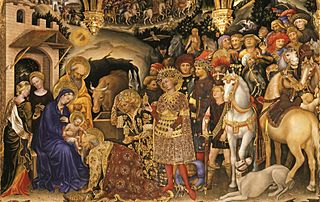
International Gothicart is a style of figurative art datable between about 1370 and, in Italy, the first half of the 15th century.
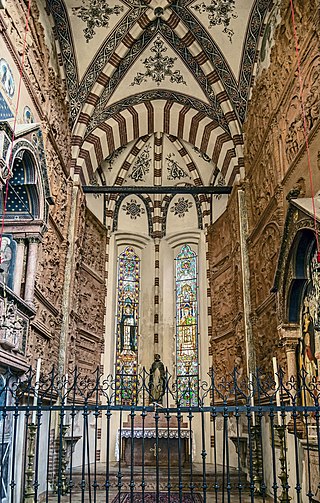
The Pellegrini Chapel is located in the apse area of the basilica of Santa Anastasia in Verona, along the right transept; it is the first to the right of the Maggiore Chapel. The chapel is famous because it contains what is considered Pisanello's masterpiece, the Saint George and the Princess, a fresco on the outer wall above the entrance arch.
{{cite book}}: CS1 maint: location missing publisher (link){{cite book}}: CS1 maint: location missing publisher (link){{cite book}}: CS1 maint: location missing publisher (link)